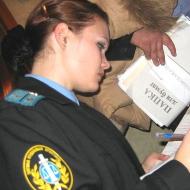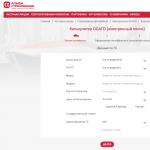
CCAD build faster than it seems. The construction of the CCAD will not be completed on the time being CCAD 1 launcher
More recently, the central annular road (CDC) was considered a project for a distant perspective, but today the highway is already beginning to acquire real outlines. Last year, the first section of the CCAD was opened for movement. The remaining start-up complexes are actively built - asphalt is laid in many places, the outlines of new junctions are visible. About how work on TsKAD is going on - in the partner project "Kommersant" and the state-owned "Autodor".
A new ring line (index A-113) will be held through the territory of the Moscow region. The future track is divided into 4 sections: 1st (South), 3rd (North), 4th (Eastern) and 5th (Western). 2nd exists in the form of a promising project. The 5th, 3rd and 1st sections are now more active.
TsKAD-West: 5th Section between Kiev and Leningrad highway
Compared to the rest of the future ring highways, the 5th section of the CCAD is, for the most part, a reconstructed "small concrete": A107 will be expanded to 4 lanes, many traffic lights will be removed from it, new junction will be removed.
Scheme of passage of the 5th section of the CCD
An option for the construction of a new route from scratch in this place was considered, but at the stage of the project it became clear that this would have to demolish too many residential buildings. Weighing everything and cons (including the financial costs of paying compensation for the redemption of the Earth), decided not to create unnecessary inconvenience to citizens and expand A107, making traversions of settlements in many places. The total length of the sections of new roads as part of the 5th section is 28.3 km, reconstructed - 41.5 km. This section will be the only free plot throughout the TSKAD - legislation prohibits the fee for travel in the absence of a free alternative detachment.
The only plot on the CCAD, which is already put into operation, is located precisely as part of the 5th section. We are talking about the 3.6-kilometer bypass of the starligor, the movement in which in early November 2017. The transport effect is already visible to the unarmed look: through the historical center of Zvenigorod, there was significantly less cars. Previously, due to the fact that the A-107 passes directly through the city, a large number of trucks accumulated at the crossroads, which was extremely negatively reflected in the ecology and condition of the ancient monasteries, estates and museum complexes.

Future disconnection of TsKAD with M1 "Belarus"
To get an idea of \u200b\u200bwhat is happening on the section, you need to make a kind of "virtual" excursion, moving from the south to the north of the "concrete". On the site between the Zedachi village (here the 5th section begins) and the Kiev highway along the A107 built two new lengths of the length of about 7 km - there are already cars for them. The "concrete" itself is closed here for reconstruction - this is a standard motion spa diagram during repairs.
On the segment between the Kiev highway and M1 "Belarus", the drivers have already seen a new bridge over the gums and a new 1.6-kilometer bypass Yushkovo. Next, the complex area of \u200b\u200breconstruction begins in the zone of dense development - for these works, contractual organizations have already been identified, the construction time will begin. Already after the intersection with M1, a new road will be built along the Petrovsky highway, which should join a new overpass (the project of FCU "CENTERTHERTOMATING", structural unit Rosavtodor), according to which drivers will fall to the Mozhaisk highway. There will be a new road (the earth canvas has already been laid, the laying of asphalt began in April), which will go around the settlements to the overpass over the Zvenigorod railway station - its construction began last autumn.

Future chief tscad with m10 "Russia"
For this erars, drivers will fall around Zvenigorod, already built and commissioned. Then the movement will again go along the expandable "concrete". Immediately at the Ilyinsky highway, in a stretch of about 2.5 km, the movement of transport is already confused into two new stripes, and two old closed for repairs. A similar situation on the plot from M9 to M10: here cars are already traveling along the new roadway. At the intersection of the M10, the 5th section ends.
The main work is now underway on the construction of artificial structures - bridges, overpasses and an overpass, their readiness is estimated by contractors at about 80%. "Willingness" in this case means that buildings are ready for laying asphalt - the coating itself will be applied immediately before the launch of the car movement.
Specifications of the 5th section of the CCAD:
|
TsKAD-North: 3rd Section between Leningrad Highway and M7 "Volga"
As part of the 3rd section, the CCAD is built a completely new route that will work in a paid mode. 105-kilometer startup It will become the longest in the rings line. The road will allow you to move from the North-West of the Moscow region to the south-east of the Moscow region literally per hour.

Passage Scheme 3rd section TsKAD
The main local attraction is a huge 1.5-kilometer bridge on 23 supports, which turns out the Dmitrov highway, the Moscow channel and the railway branch of the Savelov destination. This is one of the largest artificial structures throughout the CCAD. Already today, drivers moving through Dmitrovka may notice huge concrete bases in the Ikshi area - from here the overpass will begin "movement" over the highway. For the unhindered passage of vessels on water, the arch will be installed - it is already collected at the factory and in the coming months will be transported to the place of installation in a disassembled state. To adjust the heights between the right and left shores of the Channel Channel, a depth of several tens of meters and a volume of 2.2 million cubic meters. meters, because of which the terrain of the west of the future bridge looks rather unusual. The extracted soil, by the way, was used to build embankments on other sites.

Future bridge over the A-104, Savelovsky direction of the railway and the Canal of Moscow
The construction of the 3rd section began in December 2016, and if evaluating the total scope of work, then at the moment it is made by about 30%. In many places, the lading of the earth canvas is completed, the asphalt is laid in places: the total length of the plots with the lower layer of the foundation is about 11 km, this year will become more. To this end, 4 asphalt plants have already been mounted in close proximity to the track, they will soon be removed at full capacity.





The course of construction of the 3rd section of the CCD
The course of construction of the 3rd section of the CCD
The course of construction of the 3rd section of the CCD
The course of construction of the 3rd section of the CCD
As part of the 3rd section - 69 artificial structures (overpass, overpasses). Already clearly visible the outlines of bridges across the rivers of the Blacknava, Chernogolovka, Troy, Zagreb. Began to build one of the overpasses through the "small concrete", although in September last year there was nothing here. There is a construction of a junction near Krasnoarmeysk: for this, a new temporary highway has been erected, which residents can use. The entire local road network, on which the road technique goes today, after the end of the work, be repaired.

Future denouement TsKAD with M7 "Volga" (the project is now being finalized)
Builders promise to finish the 3rd section of the CCAD by the end of 2019. Movement on it can be launched independently of the rest of the sections. Curious item: The section is built in such a way that in the future, when it is necessary, it could be painlessly expanding for another 2 bands - for this now on bridge structures are wide supports and enhanced foundation. The extension is expected already within the second stage of the CCAD project, which can be implemented after 15-20 years. Read more about the second queue below.
Specifications of the 3rd section of the CCAD:
|
TsKAD Southeast: 1st and 4th Sections, between M7 "Volga" and M3 "Ukraine"
1st section (from M4 "Don" to M3 "Ukraine") Build Crocus Group. The company received this site in 2015 after the state-owned company "Autodor" had to change the problem performer.

The scheme of passage of the 1st section of the TsKAD
The section was quite difficult for construction: a new road takes place on a very dense-covered territory. The problem arises with the transfer of all sorts of communications (about 400 objects) - petroleum products, water pipes, a set of power transmission lines. The major main gas pipeline passes, for example, along the Kaluga highway - is now being prepared for its transfer.
In 2010-2011, when the project was preparing, no one knew that from the south Moscow would take a huge territory, for which a future annular road will be held. All this, of course, did not complicate all the processes of coordination, but the specialists of Avtodor and Crocus Group jointly solve these problems.
Specifications of the 1st section of the CCAD:
Another difficult task is to build one of the most complex junctions at the intersection of M4 "Don", A107 and the future TSKAD. Now the first piles are already scored here, it can be seen from the ground and from the air. Here are the first and fourth launchers of the CCAD.
Despite all the difficulties, about 34-40% of the total planned scope of work has already been completed. If you fly over the future road over the route, you can see how kilometers of the earth canvase are laid in many places. In some areas there is already a crushed stone mixture (this is, in fact, the foundation for the future road), in some places and asphalt. It is clearly visible from the ground, because in some places the old "concrete" passes literally from 10-20 meters from the future TsKAD. If there are no additional difficulties, in 2018, the 1st section of the CCAD should be completed and put into operation. There is a chance that some sites can be discovered for the movement of cars even earlier.
On the 4th section (from the M7 "Volga" to M4 "Don") Movement launched work on the preparation of the territory - communications are transferred, the seekers are cut down, the soil is exported. The exit of construction equipment on the band is planned soon.

Scheme of the 4th section of the CCA
Recall that in June 2017, the state company "AVTODOR" signed a concession agreement on the construction and maintenance of the 4th section with the "Southeast Highway" Consortium, after which a certain time has taken the search for strategic investors. In February 2018, during the Russian Investment Forum, financial parameters were recorded in Sochi. Investors who received shares in the consortium, became the "Autoban" group of companies, Russian Foundation Direct investment and Turkish company Makyol. The latter has serious experience in building roads not only in Turkey, but also in Morocco, Azerbaijan and Iraq.
Specifications of the 4th sections of the CCAD:

On CCAD - without barriers
The main inconvenience for users of paid roads has always been barriers in charge charges (PVP), due to which traffic jams are formed, which is especially unpleasant to the "hot" country season. In some places, it is possible to increase the number of movement bands (in the area or to the city, depending on the need), but such an option is not available everywhere.
A more progressive technology is the FreeFlow system, which allows PVP to drive without stopping: The camera reads the number of the moving car, after which the personal account of the owner is determined, from where the money is written off for the passage. Do not even do anything to the driver, everything happens automatically.
FreeFlow is planned to be used on the CCAD. The test operation of the system will begin, perhaps this year will be completed by the summer of 2019, recently stated the first deputy minister of transport of the Russian Federation Yevgeny Dietrich. "The system must work out for some time in the mode of pilot operation so that people looked at it are accustomed and understood what it is," he told. - According to preliminary estimates, the period of test operation should end to May-June next year. " The FreeFlow project will be engaged in a single operator, which will create the Gosset Autodor.
In order for the passage without barriers to earn, changes are needed in the Code of Administrative Offenses of the Russian Federation: you need to enter fines for drivers who are decided to drive along a raid area without making payment. The relevant amendments to the legislation already by the Ministry of Transport and will soon be planned to be submitted to the State Duma. The estimated fine size is 5 thousand rubles. Experts are now discussing where he must go - to the budget of the state or the concessionaire.

It will look like a collection of plans for the CCAD, which provides for the application of Freeflow technology
CKAD-2: Myth or Reality?
From the point of view of the average person seems to be strange to plan the expansion of the road, which is not yet built. But in fact there is a certain logic. For example, when a Novorizhskoe highway was designed in the distant 70s, then the flow streams were small, four lanes were quite enough.
But the Soviet engineers decided to leave the descendants to the descendant in the form of a dividing strip, which could be used to expand the carriageway. What, as a result, the next generation of road users and took advantage.

In general, this is a standard Western practice - to start in 20-30 years to prepare corridors for future tracks. With TsKAD similar situation. It is already clear that after a few decades the need for expansion and this highway may arise, especially since it is planned to be used as part of several international transport corridors.
The technical documentation for sections is mentioned "second queue", which will be designed after increasing the transport loading of the first stage of the CCD. Within the framework of the 3rd section, an expansion from 4 to 6 bands, the construction of the oriental exit to the Dmitrovskoye highway, the northern exit to Noginsk, the junction with the Pushkino-Krasnoarmeysk road and the Shchelkovskaya highway is already scheduled. At one of the sections of the 4th section, it may occur to an extension of the number of bands from 6 to 8 and an interchange will be built with the "MMK-Chechevilovo-MBK" highway.
As part of the second stage, most likely, the mysterious 2nd section will appear - the M-shaped "process" from the main ring, which will begin somewhere between M3 and M2. The history of this site, in fact, is not so mysterious: during development, designers were not allowed to walk near the lands of the Taman Division (owned by the Ministry of Defense), so the CCD was redirected to the other side - bypassing Naro-Fominsk. Later it was decided to make the main ring on another route - according to the "concrete", and the 2nd section should be left for the future. It is possible that someday, after 10-30 years, it will be the beginning of a new infrastructure project - Doubles of the "Big concrete" plot called TsKAD-2.
A large-scale infrastructure project is already called the infinity ring and the project of absurdity worth hundreds of billions rubles.
Photo: Government of the Moscow Region
Stop pulling the budget for one place?
Well, so I burst into the Kremlin for patience about this endless construction. Vladimir Putin ordered to create an operational headquarters to eliminate the lags on the project and prevent value growth in the future central ring road (CCAD). Another order was given to the General Prosecutor's Office, the Investigative Committee and the Accounts Chamber. The departments of Yuri Seagulls, Alexandra Bastrykina and Alexey Kudrin will have to test the observance of the interests of the state at the conclusion and implementation of state contracts, as well as the validity of the increase in the cost of construction of the CCD.
By itself, the central annular road. The goal is beneficial - unload radial tracks and reduce the dependence of heavy trucks from highways. The ring is built as an alternative to the old concrete ring and after expansion it must be transformed into a full-fledged motorway, a long 525 km (ring itself is about 340 km). The road will be paid - the Moscow Small Ring will remain free alternative. CCAD will take place in a detour of large settlements of the Moscow region.
For the first time, the need to build TsKAD was spent in 2011, but seriously spoke about the project only in 2016. Open the first sites were planned already in 2018, but now their surrender was transferred all the time.
TsKad is divided into five sections, which "autodor" calls start-up complexes. Directly ring form areas No. 5, No. 3, No. 4 and part of the site No. 1. Plot No. 2 together with a piece of section No. 1 form an additional branch, which should associate federal highways: M3, M1, M9 and M10. True, the branch exists so far only on paper, it is planned to build after 2020.
The state was taken most of the financing, which allocated 150 billion rubles. Directly from the National Welfare Fund (FNB). About 80 billion rubles. The project is highlighted as subsidies, the remaining funds "Avtodor" was to find independently - that is, to attract private investors to the project. However, in this regard, Autodor did not succeed - in contrast to inflating the estimates. In general, the construction site checked the Accounts Chamber and found multi-billion dollar disorders.
Whether the construction is - either no
The check revealed that in addition to regular transfer of the time of delivery of the road, the total estimate increased by 13 billion rubles. Also in the Avtodoru report, there were claims for transferring land for the construction of the road for 2018-2019, which again puts the implementation of the project questioned.
There is no clarity and using budgetary funds - from the draft 62.6 billion rubles allocated on the Passport on the CCAD, only 38.4 billion rubles were involved. And 8.8 billion rubles, which the state-owned company should have attracted in the form of private investments and remained in words.
If you look at each of the sites, there is a situation even running. At the beginning of April, according to the Accounts Chamber, the first section of CCAD was ready only 15.6%, the fifth - by 33%. According to the third site, formally "zero readiness", since the acceptance of the work was not carried out, and at the fourth site at all while the "horse was not lying."
But in the "Autodore" do not see the problems in this - the main thing that was found money for the construction of the site. True, no investors were saved by investors - and the State Sberbank, Gazprombank and the Eurasian Development Bank, which were provided by the Company with a loan of 31.6 billion rubles. for 15 years.
Agalarov "Nood"?
And also the Accounting Chamber caught Avtodor GC and Contractor Crocus International JSC from Crocus Group Businessman Arases Agalaryov on the fact that they would not cope with their obligations. Therefore, the cost of CCAD increased almost one and a half dozen billion, and the delivery time was shifted for 2019.
According to Valery Bogomolov's auditor, he checked financial activities Participating in the project of state-owned companies and private investors for the period 2016-2017 and came to disappointing conclusions:.
"... Over the past two years, the Avtodor Group and Crocus International JSC, which is a contractor for the construction of the TsKAD number 1 launcher, did not fulfill their obligations ...".
During the audit, some strange "subtleties" of relations between the "autodorm" and "crocus" were also revealed. For example, AVTODOR GK, in violation of long-term conditions investment Agreement According to the construction of the starting complex No. 1, the Crocus International Agalairov advance payment of 14.6 billion rubles was paid, exceeded the allowed advance amount by 5%, which was expressed in tens of millions of rubles overpayments.
Yes, and the money was transferred to the implementation of 35% of the work, and was fulfilled on the fact it turned out to be only 23.4% of the prosecuted work. And the technical willingness of the TSKAD site, erected by Agalairov, at that time was only 15.6%.
Inspectors from the Auditor's apparatus Valery Bogomolov found out that in accordance with the design of the construction of the construction at the first TSKAD project complex in 2017, about 1.1 thousand workers and 638 cars and mechanisms were to work.
"Visual inspection construction site Our employees showed that less than 50 workers and no more than 30 units of technology are at the construction site, "Valery's auditor was outraged.
Also during the verification of the activities of JSC "Crocus International" on the CCAD, it turned out that the top layer of the road surface was laid down on the highway, and the longitudinal evenness of the highway does not correspond to GOST.
At the same time, as inspectors of the Accounts Chamber of the Russian Federation, the poor-quality work of the structures of Crocus International JSC ARAS AGALAROVA was paid to the Avtodor Group in the amount of 40.3 million rubles, - approve in the Accounts Chamber.
Sergey Kelbach, Chairman of the Board of the State Civil Code, at a meeting of the Accounting Chamber justified - they say, JSC "Crocus International" promised to eliminate all violations on the roadway.
Ring goes to a dead end
Main Moscow Region Construction - CCAD Draws not first year: Objects do not surrender on time allocated money on them "hang". And the trouble knocks on the gate not only by the breakdown of the brainchild of Agalar. Not much better and in other sites of construction.
When verifying the auditors of work for 2016-17, it was revealed that at the start-up complex number 3 for reporting period The works were not accepted and not paid, although by the end of this year the objects in the amount of 19.6 billion rubles should be built here. Now the deadlines for the delivery of this site are shifted at least a year, while the "autodor" adjusted the project documentation without the consent of the Glavgosexpertiz.
Works on the launch complex number 4 were to begin in July last year, but as of January 1, 2018 so nothing was done. And what can be done in general, if even the construction permits are not received in Rosavtodor?
At the starting complex No. 5 of work in 2017, only 60% were fulfilled, and the overall readiness of the object is 33%, despite the way that it is necessary to pass it in December 2018 ...
In addition, the main work on the transfer of communications was to be completed in 2017, and the construction of the plots - at the end of 2018. The appropriate instructions gave President Vladimir Putin. But by the beginning of the year, the first plot was built by 16%, and the fifth - by 47%.
In addition, contractors have problems with renewal and alienation of land, which must be involved in construction. In general, the problems of the car and the cart. Construction rack and becomes more and more expensive.
And a significant increase in the cost of the project is not the only scandal associated with the construction of the central annular road. Back in 2016, information appeared on the preparation of the Public Chamber of Appeal to the Government of the Russian Federation with a call to suspend work. According to the coordinator of the Forest program "Greenpeace Russia", Alexei Yaroshenko, an avalanche-shaped settlement of the territory around the track will lead to a fall in the quality of life and a new inflow of "applicants" from the region.
Other environmental experts stated that the territories are mastered exclusively in the interests of the business, and during the construction of the CCAD will be cut down 5-6 thousand hectares of forests - which will cause a serious damage "Easy Capital". The total environmental damage is estimated at 11 billion rubles.
Experts urge to revise the project and transfer construction to neighboring areas, as well as freeze construction to re-ecological expertise. But officials do not even convince the fact that potential investors are also not ready to build a CCAD, including due to high financial risks.
Such a project is a big mistake?
About minuses and risks In the construction of the CCAD in the Public Chamber, they spoke from the very beginning of the project. Environmentalists, scientists and social activists believe that the 339-kilometer route will cause irreparable damage to the Moscow agglomeration.
In addition to the above-mentioned environmental damage and risks, the specialists are confident that the experts needed to build not in the suburbs, but in the neighboring areas to take transport from Moscow.
Love Chernyago, Candidate of Geographical Sciences, Head of the Expert Council of the Environmental Union. I am confident: the decision to build a CCAD project on a scale and such configuration was, of course, the most severe error or a crime.
In her opinion, the project is harmful and unpromising, because anyway, even if they build a CCAD, there will be traffic jams. This problem is impossible to solve otherwise, as developing public transport within the Moscow region.
"We need an annular road outside the Moscow region. This is very important from the point of view of investment and from the point of view of traffic and communication between the regions, "said the love of Chernyago. - We need other transport solutions inside the Moscow region, which will not cause damage to ecology, which will better contact various parts of the suburbs of the capital. "
The most reasonable decision, according to specialists, is a phased, calculated for many years the development of a network of high-speed highways between the administrative centers of the European territory of Russia. Formation of a system of logistics centers outside the Moscow region (in Tverskaya, Vladimir, Tula, Kaluga regions).
Why do you need a road - money and so much
Of course, the opinions of experts are divided - some say that this is a mistake, others claim that the road is needed. But what, most importantly, what price?
The construction of CCAD is already called one of the most "sawing" projects of Sergei Kelbach. By the way, the theft of money allocated to the CCD has already been investigated by the competent authorities. For example, the Investigation Department of the Russian Federation of the Russian Federation previously initiated a criminal case about the embezzlement of about 9 billion rubles, intended for the CCD.
The money was paid from Investment Fund Russia for development project documentation TsKad. However, as a result of various schemes "unidentified persons", these funds were kidnapped. Some of them were cashed.
At one time, the State Committee, headed by Sergey Kelbach, challenged the claims of FAS to the contest for the reconstruction and the content of 76 kilometers of CCAD. And the capital Court of Arbitration Satisfied the lawsuit of Avtodor to the FAS on the abolition of the decision of the service issued on the complaint of Stroygazconsalting. The dispute went around the right to reconstruct and contain a 76-kilometer section of the CCAD, the cost of the contract is 42.4 billion rubles.
Then the contract received the ACS company affiliated with the structures of Gennady Timchenko. Stroygazkesalting Ruslan Baisarova, who took second place in this competition, complained to the FAS to the results of the competition. A businessman presented the data according to which the comparison of applications was biased, and the score, the company, unreasonably low.
"Stroygazkesalting", which is building the first section of the CCAD, received a lower score on the next fifth section of the lower point according to the criterion "Organizational and Technical Proposals". FAS agreed with complaints. After all, the price proposal of Stroygazononsulting was lower than the ARKS: 39.4 billion against 42.2 billion rubles.
But as a result, the victory of ARKS provided the criterion "Organizational Proposal", to evaluate which points at their discretion exhibit members of the Competition Commission. It turns out, "overlapping" the number of points for ARKS was the affair. And as we see, the corruption component is evident, because the "Stroygazkesalting" could build this section of the track by 2.8 billion rubles. Cheaper.
The media wrote that Timchenko could become the true cause of the lobbying of Kelbach of interests of these 2.8 billion rubles. It seems that the pressure of "Avtodor" on the FAS is due to the fact that Timchenko and Kelbach could have already arranged about the "share" after the intended "development of funds".
And on this "Miracles in Seret" do not end. Various sources describe other amusing ways to scroll through the funds allocated for the construction of Trasi. For example, the autodor instead of the construction of TsKAD put about 20 billion rubles on the bank account at the bank account, the interest on which they go to the award leadership. 20 of 39 billion, fallen "autodora" in 2015 from the FNB and the Ministry of Transportation on the construction of the road did not work, falling on a deposit in Gazprombank. But according to the calculations of the auditors, interest on the deposits of the Avtodor Group of Companies and the Ring Highways LLC (owned by the GC ARKS Gennady Timchenko, builds the 5th section of the CCAD) from the placement of the funds allocated to the CCAD already exceeded 2 billion rubles!
It turns out, autodor instead of construction of roads joining a budget account! It turned out to be a response to the question: why contractors for the construction of the 1st and 5th sections of the TsKAD practically do not build objects. They, shifting advances on the deposits from the Avtodor GC, dispose of interest income with them. Although there is a prohibition of Ufas.
The effectiveness of multi-billion dollars is in doubt, they could serve as a source of additional budget revenues, stated the Chairman of the Accounts Chamber of Tatyana Golikova. But officials care not about the treasury ... Avtodor received only 5% approved according to the plan of work (by 119 million rubles)!
According to the Center for Research Research Society, with reference to the Union of Energy Engineers, the average cost of construction of one kilometer of the highway in Russia is about $ 13 million (and taking into account the constant weakening of the ruble - will only grow), and in China - only 2.9 million . We have more expensive road construction than in Germany, Poland and the United States.
Corruption in Avtodore is not just cut, but the real threat of national security, because every year per 100 thousand Russians recorded 18.9 mortal cases on the road. This is two times higher than in Europe.
As for the road, even the head of state drew attention, then it is not yet, and when it will be unknown. But at the cost and level of scandals, it already beats all records. Probably, like most projects "Showman" of paid roads - Sergey Kelbach and the Special State Committee on the Autodor.
And such things will always occur - regardless of the importance of projects. The cost will grow, breaking the delivery time ... But the cause of the problem lies on the surface - there is no proper control, there is actually no competition. About how contests are held in our country - this is generally a separate song.
But be supervision - it would not be incomprehensible where there are billions of rubles of budget money. Yes, and in the presence of competition, it would not be necessary to grab the head in the case when one or another contractor did not cope with the task. You can always find someone to convey the "relay".
And malicious violators would cost generally to make a "black list" and to orders of state importance for a gun shot. Not looking at the loud names that are found in shareholders of companies. To give the way to those who work honestly and openly - to show that in our country you can earn, not only war.
And this is the question of what corner is dormant, including our law enforcement agencies - the prosecutor's office, the investigative committee? This is because of the part of the Lords Chaika and Bastrykina to plant thieves in prison. And instead, we have, as usual - if where is a dead end - you have to personally ruin the president of the country. Does it affect some kind of construction, albeit important?
Moreover, even being dissatisfied with how the construction of the TsKAD is going on, for whom right now the head of state can replace "autodor"? Only on ... "Autodor". Because the winged phrase about the "fools and the roads" will still be our national treasure ...
Two sites of the launch complex No. 5 of the central ring road (CCAD) are planning to put into operation in December 2019.
After the complexion of CCAD-5, together with the contractors, representatives of the State Avtodore company announced an increase in the pace of work. For December 2019, the opening of two objects with a total length is scheduled. 35.08 km:
- segment of the track from the border of works with CCAD-1 to Kiev highway
- cut from Mozhaysky to Novorizh highway.
Now, on the fifth launch complex, work on artificial structures, an emergency room device, road clothing, as well as laying asphalt concrete. According to the press service of the Avtodor Group of Companies, it is fully planted to fully pass this launch complex in 2020.
CCAD-5 will be the only free district Ring highway. On other sites, the fare will be about 3 rubles. per kilometer. Residents of the Moscow region benefits will not receive.
The fifth launcher of the CCAD passes through Odintsovo, Istra, Solnechnogorsky and Naro-Fominsky City District. The total length is more 76 km. 28 km accounted for a plot of new construction, 48 km - On the reconstruction site A-107, with the broadening of the roadway up to four lanes.
Construction of the fifth start-up complex TsKAD
The third of the launch complex number 5 (plots from the 18th to the 36th km and from the 43rd to the 50th) passes through the Odintsovo district from the north to the south - bypassing Zvenigorod and along the Small Moscow Concrete Ring.
The route crosses the main transport arteries of the municipality - Minsk and Mozhaisk Highway. At the moment, the movement is launched only on one section of the launch complex number 5. This happened in November 2017.
Tskard does not solve the problem of Mozhaisk highway
However, there is still an unknown question with an extremely important object - an overpass over the railway tracks on the crossing of Petrovsky highway in the village of Small Visomas. This section of the A-107 highway is strongly overloaded with transport, during the daytime there are a few kilometers long. The tail of the traffic jam also stretches to Golitsyno on the Mozhaisk highway and in Petrovsky highway towards the M-1 highway.
Without an overpass, the CCD will not be able to fulfill the stated target - unloading near Moscow tracks. The overpass was initially not included in the TSKAD-5 project, but later there was information about the start of the project development. But he never was published.
In May 2019, users of transport forums reported that the overpass project should be ready for autumn.
TsKAD does not solve the problem of the Mozhaisk highway
Fully open the road to 2022
The project of the Central Ring Road was developed in the early 2000s. Purpose of the road - unloading of the Moscow Ring Road and federal routes. The length of the CCAD will be 525 km.
In 2015, the track began to build. Initially, commissioning was scheduled for 2018. But the deadlines were repeatedly transferred: first for 2019, then 2020.
In April 2018, the Accounts Chamber in the construction of the CCAD in the period 2016-2017 and reported an increase in the cost of construction on 13.5 billion rubles. Vladimir Putin Prosecutor General's Office, Investigative Committee and Accounts Chamber.
In February 2019, the Accounts Chamber reported on the results of the inspection: construction due to systemic problems and not enough effective project management. Also identified violations that led to an increase in the cost of work.
Head of HC "Avtodor" Sergey Kelbakha sent to resign, his place occupied Vyacheslav Petheshenko. The new leader stated that the backlog during the construction of the CCAD was due to the quality of the project, land issues and artificial structures.
In March, "Vedomosti" learned that on the construction of the road. From the budget, 11 distressed points were found, which will prevent the movement. Almost all works concern the start-up complex number 5.
Fifth launchers TsKAD
In June 2019, the Special Representative of the President of the Russian Federation on environmental protection activities of ecology and transport Sergey Ivanov He stated that the entire TsKAD plan to introduce not in 2020, but in 2021 - early 2022. At the same time, he added that all the first sections of the CCAD are already in a high degree of readiness.
(1)
The central ring road (CCAD) is the largest and ambitious transport project, which is implemented in the Moscow region. This high-speed impetor road will be held 50 kilometers from the Moscow Ring Road and unload radial "flying" routes in the Moscow region.
Travel on TsKAD will be mainly paid for the exception of a number of areas. The start of construction has been transferred more than once, as a result, the solemn start was given in 2014. In 2019, it is planned to complete the construction of four start-up complexes of five, and the areas will not give up in order.

- Total length: 529.9 km
- Calculated maximum speed: 150 km / h.
- Number of strips: 8
- Number of start-up complexes: 5.
- Terms: By 2019, it is planned to build 339 kilometers of the track
The solemn ceremony of the beginning of the construction of the first tricks complex TsKAD took place in August 2014.
The route will be held in the south-west of the Moscow region, between M-4 DON and M-3 "Ukraine" roads, in the territories of the city district Domodedovo, Podolsky district, the Trinity administrative district of Moscow and the Naro-Fominsky district of the Moscow region.
The first startup complex will have four lanes in both directions, modern junctions and overpass, allowing to develop a speed of up to 140 kilometers per hour. Its operation will be paid.
CCAD scheme

The central annular road of the Moscow region (CCAD) is designed in accordance with the Federal target program "Modernization of the Transport System of Russia (2002-2010)" approved by the Government Decree Russian Federation from 05.12.2001.
The implementation of the CCAD project will solve the following main transport, social and economic tasks:
- Unload radial outputs from Moscow and the city's street network from the movement of heavy and transit transport.
- Rationalize the structure of the load distribution, "intercept" in long-range entrances to Moscow vehicles, with the subsequent lifting of goods and sending them to other regions with small parties.
- Create a road component of international transport corridors (MTC) - №2 (London - Berlin - Warsaw - Minsk - Moscow - Nizhny Novgorod), №9 (Helsinki - Saint Petersburg - Moscow - Kiev - Southeast Europe), MTK "North-South" and MTC "Helsinki - Moscow - Nizhny Novgorod" passing through the territory of the Moscow region.
- To form conditions complex Development Infrastructure and territories of Moscow and the Moscow region, as well as related regions - Tverskaya, Yaroslavl, Vladimir, Ryazan, Kaluga, Tula and Smolensk based on the multiplicative effect of the construction of the CCAD.
- Intensify social, economic, interregional and international relations, increase the level of mobility of the population and market entities.
- Increase road safety and quality service of the automotive road.
- Reduce the cost of transportation and the level of transport costs for shippers.
- Reduce the level of negative impact on environment Due to the unloading of head sections of radial roads in the Moscow region.
- Optimize (reduce) budget expenditures at the construction stage by attracting extra-budgetary investments in the framework of the concession agreements.
- Optimize (reduce) budget expenditures at the stage of operation by attracting concessionaires to the expenditure of funds for the maintenance of the road.
- Provide transport infrastructure implementation of comprehensive development programs for the territories of the Moscow Region, carried out without funding from the budget of the Russian Federation.
In order to design the road, it is divided into 5 launchers and 10 sections.
First launcher:
- Start of construction: 2014
- Ending construction: 2019
- Length: 49.5 km
1 Startup:
- In the area of \u200b\u200bthe Small Moscow Ring from the M-4 "Don" route to the M-1 Belarus's highway in the region of the Great Moskovsky Ring
(1 plot; length 49.9 km; stripes - 4-6 ; Junites - 3 )
(2 plot; extension 63.85 km; Strins - 4 ; Junites 3 )

2 launchers:
- In the area of \u200b\u200bthe Grand Moskovsky Ring from the M-1 "Belarus" route to the Moscow-Saint Petersburg high-speed road Moscow - St. Petersburg
(3 plot; length 52.1 km; Strins - 4-6 ; junction - 3 )
(4 plot; length 37.2 km; stripes - 6-8 ; Junites - 1 )
(5 plot; length 28.56 km; stripes - 4-6 ; Junites - 3 )
3 Startup:
- In the area of \u200b\u200bthe Small Moscow Ring from the high-speed motor road Moscow - St. Petersburg to the M-7 Volga highway
(6 plot; length 53.9 km; Strins - 4-6 ; Junites - 4 )
(7 plot; length 50.75 km; Strins - 4-6 ; Junites - 4)
4 Startup:
- In the area of \u200b\u200bthe Small Moscow Ring from the M-7 "Volga" route to the M-4 Don highway
(8 plot; length 59.1 km; stripes - 4-8; junction - 5 )
(9 plot; length 36.6 km; stripes - 4-6 ; Junites - 2 )
5 Startup:
- In the area of \u200b\u200bthe Small Moscow Ring from the M-3 "Ukraine" route to the high-speed motor road Moscow - St. Petersburg
(10 plot; length 89.97 km; Strins - 4 ; junction - 6 )

Total: length - 521.63, junction - 34
Concession:
1 launcher - 1 plot
3 and 4 launchers - 7,8,9 sections
At the stage of substantiation of investments on the basis of economic research data, the forecast of the intensity of motor transport movement was drawn up and two scenarios for the development of the CCAD were considered.
According to the first scenario, the track was laid with the maximum use of the bandwidth and structural elements of the Moscow Small Ring (MMK) and the Moscow Big Ring (MBC), according to the second direction.
As a result of a comprehensive analysis, it was found that car roads A-107 and A-108 have parameters of the III-IV categories, a significant number of sections with small radius curves in terms of and longitudinal slopes exceeding 40%, numerous intersections and adjoining in one level, displacement Plots of roads in the plan.
For more than 40 km, the road A-107 passes through the cities of Noginsk, Elektrostal, Bronnitsy, Zvenigorod and others settlements. In these places, the distance to the development is 5-30 m. The reconstruction of these roads according to the parameters of the I category is associated with the almost complete restructuring and according to the conclusions made in justifying the investment inexperts.
Another argument in favor of the construction of a new route is the ability to increase road density in the Moscow region. Now one of the reasons for the high intensity of movement on the roads of the Moscow region is the low density of roads.
With the level of motorization of the population of the Moscow region comparable with the level of motorization of the population of Europe, the density of road network in the area of \u200b\u200b4 or more times lower than in Europe, the size of which is close to the territory of the Moscow region.
For ten years, the number of passenger cars has sharply increased, both in Moscow (1.6 times) and in the Moscow region (2.9 times). number trucks In Moscow and the Moscow region increased by 2.6 times. The construction of the CCAD will increase the density of roads with solid coating.
The new route will be the basis of the high-speed main roads of the Moscow region. The total length of the automotive road will be 521.63 km.
Basic technical parameters of the central annular road
The road will be equipped with a modern automatic road traffic control system, meteorological observation stations, helicopter venues, emergency facilities, drivers for drivers and road service areas.
The planned deadline for the construction of the facility (taking into account the training of the territory) - 2014-2018.
Causes of creation
In addition to key technical factors for the construction of the highway, among which experts particularly identify its small load and lack of a large number of congresses and intersections, this project has a whole range of social and planning and urban reasons.
So, if the authorities decided to go along the way to the reconstruction of "concrete", they would have had to face discontent of people whose homes are near the highways. For example, A-107 runs next to those large cities, as:
- Noginsk;
- Bronnitsy;
- Elektrostal;
- Zvenigorod;
- Domodedovo.
At the same time, buildings are located at a distance of just 5-30 m from the "fifty-cell meters". The buildings would be inevitably demolished in case the designers began to expand existing trails.

Note that the central ring will be a 1st technical category road (I-A). This means that the curvature, the width width, the degree of longitudinal slopes and other highways will respond strictly established standards. Therefore, even heavy trucks can safely move at high speeds.
Free A-107 and A-108 cannot boast of compliance with the adopted standards. In order to fit them under the regulation, both highways would have to completely redo, incl. Destroy many adjoining, intersection, displacements and junction. Such reprovers of the transport canvase would be much less appropriate than the construction of a new road near Moscow.
Concept of future development
The authorities are developing plans for the construction of 3 additional transport arteries in Novomoskovsky and Trinity Districts. The junctions will appear at the intersection of CCAD with Kaluga and Warsaw highway and near 26 picket, and their length will be more than 22 km. This department of transport decided to limit it in order not to overfill the transit path.
Recall that the embodiment of the CCAD scheme for the first time began in December 2015. The project, which took over 300 billion rubles to the implementation, was intended to create a modern 530-kilometer highway.
His financing was held using 3 sources:
- investments of investors and concessionaires;
- funds of the National Welfare Fund of Russia;
- subsidies from the federal treasury.

On the paid road fabric (Eastern, North and South Poblers MMK, or A-107), motorists will be able to develop a speed of 140 km / h, and on the only free plot (Western) - 80 km / h. To the final stage, which will fall at 2020-2025, the CCD will be the largest multifunctional transport and logistics center of Moscow and the Moscow region.
Pluses from the construction of TsKAD
Thanks to the construction of the CCAD, not only at the Moscow region, but also from other nearby regions, everything will appear required requirements For progressive development of infrastructure, due to which the cost of freight will decrease, improve transport accessibilityconnecting the capital with regions, which is extremely important for people living beyond the city. For example, it is very relevant for those who live in cottage settlements Or only plans to buy land in Schelkovsky highway. See the General Plan. And, most importantly, it became known that the construction period of the first section of the CCAD will be reduced from six to four years, without changing the cost of the project - the Minister Mikhail Abyzov reported the other day. The cumulative value of the first section of the central ring road will not be changed, since, due to a number of reasons, there is a reserve, due to which the cost is reduced. Completely completing the construction of the CCAD is scheduled for 2019, and the total investment is about three hundred billion rubles.
Video About the construction of CCAD in 2019.
System problems and not enough effective management of the project led to a breakdown of the construction time of the central annular road. *
As of December 1, 2018, the construction readiness of the CCAD was from 0% to 66%, which would not allow to complete the work at the start-up complexes No. 1, No. 3 and No. 5 earlier than 4 quarters of 2020, and at the start-up complex number 4 - earlier than 2 quarters 2021 g. **
"Since 2015, the Accounts Chamber annually monitors the construction of the CCAD and more than once paid attention to the low pace of performance. In January 2018, plans for the elimination schedule were adopted by the emerging lag of work at the start-up complexes No. 1 and No. 5. However, they were not fulfilled. GK Avtodor has already sent proposals to the Ministry of Transport to transfer the timing of the completion of work for December 2020. Thus, the revenues from the OPERATION of CCAD, scheduled for 2019-2020 in the amount of 22.4 billion rubles, the state-owned company will not be received. "- said the auditor of the Accounts Chamber of Valery Bogomolov, reporting on the Collegium of the Office the results of verifying the effectiveness of the expenditure of funds aimed at implementing investment project for the construction of the CCAD.
According to the Accounts Chamber, the main reasons for the disruption of the deadlines of the end of work is the low quality design and duration of the procedures for withdrawal and design land plots.
In addition, the number of workers and road construction equipment at all start-up complexes does not comply with the construction project and not enough to eliminate the lagging for work.
At the date of completion of the inspection (December 2018), the state company did not adjust the design and estimate documentation for changing the boundaries of the road removal band and reorganization. As a result, due to the exit of the structures for the bandwidth on the start-up complex number 1, it is impossible to start building 8 above-ground pedestrian crossings. In addition, the design and estimate documentation does not provide for the reorganization of 79 engineering communications. At the same time, without them, it is impossible to proceed to the construction of a number of areas of the road and artificial structures.
In addition, the state company did not approve design and estimate documentation For separate local CCAD activities. No contracts for the construction of 2 transport junctions, a road section, as well as to reorganize a number engineering networks and withdrawing individual land plots. Therefore, it is impossible to determine the full cost of building CCAD currently.
On November 15, 2018, extrabudgetary financing was only 14 billion rubles. The funds were sent in 2018 to the construction of a start-up complex number 3 as part of the implementation of the concession agreement and amount to 52.6% of those provided for 2017-2018. volume (26.6 billion rubles). For other agreements, investors are not attracted. The current situation indicates non-fulfillment of investors to co-financing the project and does not comply with the principles of public-private partnership.
In the course of the verification of the execution of concluded agreements, a number of violations were established, including the intensification of the cost of adopted and paid work. Thus, on the first and fifth start-up complexes of the State Committee, made changes to the construction projects in the part of the device of the earthen canvas and road clothing without the passage of re-government specialism. At the same time, as a result of the specified changes, the cost of work increased by 5.7 billion rubles. and 900 million rubles, respectively.
Check also revealed ineffective use of resources created at the expense of funds federal budget. So, during the preparation of the territory for the construction of the third start-up complex, the authodor paid for the work on the reorganization of communications in the amount of 415 million rubles. However, paid work remained not in demand due to changes in the reorganization plan.
The first deputy minister of transport of Innogenius Alafins, present at the college, spoke about what is currently being made to eliminate the lag from the schedule. According to him, in accordance with the instructions of the President in November 2018, an operational headquarters was formed. In weekly mode, including in the format of field meetings, it monitors the construction of the CCAD objects. "A single schedule of events was approved, designed to eliminate the lag in the construction of the first trigger complex CCAD. The mechanisms for implementing this schedule are also formed, material, technical and labor resources are increased at facilities. Performers and contracting organizations are reported weekly uniformthat allows you to objectively assess the course of work and the need to attract additional equipment "- explained Innocent Alafins.
College decided to send: information letters President of the Russian Federation and in the Ministry of Transport of Russia; performance - in GC "Autodor"; Appeal - in the FAS; Report - in the Chamber of the Federal Assembly, the General Prosecutor's Office and the Investigation Committee.
Reference Information:
* Passport of the CCAD project provides for the completion of construction at the launch complexes No. 1 and No. 5 in December 2018, at the start-up complexes No. 3 and No. 4 in December 2019.
** startup number 1. - from the intersection with the automotive road of the federal value of M-4 "Don" before the start of Bypassing the city of Naro-Fominsk, with a length of 49.5 km;
startup number 3. - from the intersection with the M-11-Saint-Petersburg high-speed road of M-11 "Moscow-Saint Petersburg" before intersection with the automotive road of the federal significance of the M-7 Volga with a length of 105.3 km;
startup number 4. - from the intersection with the road of the federal value of the M-7 "Volga" before intersection with the road of the federal value of the M-4 "Don" with a length of 96.5 km;
startup number 5. - from the beginning of bypassing the city of Naro-Fominsk to the intersection with the M-11-Saint-Petersburg high-speed motor road under construction of 87.7 km.
















